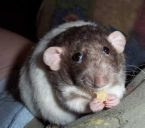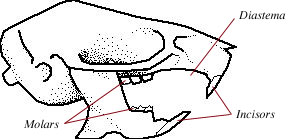http://www.ratbehavior.org/Teeth.htm
Mammals have four kinds of teeth, that differ in shape, function, position in the mouth, and whether or not they are replaced. The four types are incisors, canines, premolars, and molars.
|
|
| Figure 1. Drawing of a rat skull, showing the placement of the molars, incisors and diastema. © anne_rats |
Rats do not have canines (the conical, pointed teeth used for holding prey, defense, and combat), or premolars (grinding teeth behind the canines and in front of the molars). The rats have a long, toothless space in their mouth where the second incisors, canines and premolars would be. This space is called the diastema.
The number of different types of teeth in a species is described with a dental formula, which is written as: I n/n C n/n P n/n M n/n where I, C, P and M refer to the incisors, canines, premolars and molars respectively, and n/n refers to the number of upper and lower teeth of each type found on one side of the mouth. So, the rat's dental formula is: I 1-1, C 0-0, P 0-0, M 3-3. Rats have 8 teeth on the lower jaw and 8 on the upper, a total of sixteen teeth.



0 comments:
Post a Comment